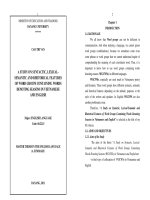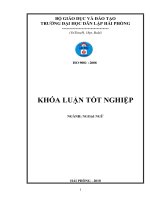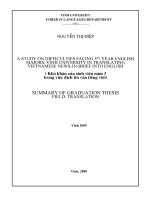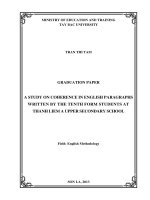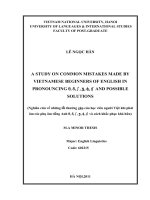A study on some major factors affecting English learning of grade 6 ethnic minority students of a mountainous secondary school to help them learn better
Bạn đang xem bản rút gọn của tài liệu. Xem và tải ngay bản đầy đủ của tài liệu tại đây (221.08 KB, 39 trang )
CHAPETR 1: INTRODUCTION
1.1. Rationale
It is undeniable that English is one of the major languages in the world. It links
people in many fields: science, technology, business, communication, education, etc.
Nowadays, English is popular enough to be spoken at every corner of the world. Therefore,
teaching and learning English have become the necessity in every country.
In Vietnam, English is one of the foreign languages that are compulsory from
primary school to university. However, there are differences in English learning results
among students from different minorities as well as different areas. Teaching English to
ethnic minority students in the remote and mountainous areas of Northern Vietnam has long
been a controversial issue. In Sonla, it is a fact that there exists a big gap between students in
towns and students from minorities in mountainous areas. . Minority students in
mountainous schools are considered to learn English not so well as those in towns. What
factors can affect their learning process is my question for that problem. Hence, I have
chosen that topic for my thesis namely “A study on some major factors affecting English
learning of grade 6 ethnic minority students of a mountainous secondary school to help
them learn better”. I hope that this research can give a few benefits to teachers, students
and people concerned about this field.
2. Hypothesis
Up to now, there are many factors affecting English learning of grade 6
th
minority
students, and different factors affect them in different ways and different levels.
3. Objectives of the study
The main objectives of this study are as follows:
• To identify the present situation of teaching and learning English of teachers and
grade 6
th
minority students at Phỏng Lập secondary school.
• To find out some major factors affecting their English leaning .
• To find out which the most important factors are and which the least ones are.
1
• To give some suggested solutions, which could be useful for teachers and learners in
teaching and leaning English at mountainous secondary schools.
4. Scope of the study
For the limitation of time, conditions, and materials, this study only focuses on some
major factors affecting English learning of some grade 6 ethnic minority students at Phong
Lap secondary school. In addition, this thesis is also carried out on some teachers of English
in this school which can help us to see some major factors affecting English learning to
grade 6 students in this school more obviously.
5. Methods of the study
Carrying out this research, the following methods have been used:
• Theoretical study
• Survey (questionnaire)
• Interview
• Class observation
6. Research questions
In the thesis, the following questions will be answered.
1. What is the present English learning situation of grade 6 ethnic minority students at
Phong Lap secondary school?
2. What are some major factors affecting their English learning ? What are the most and
the least important ones?
3. What are suggested solutions to the study?
7. Overview of the study
The study concludes five main following chapters:
Chapter 1: Introduction
2
Chapter 2: Literature review
Chapter 3: Data collection and analysis
Chapter 4: Major findings and discussions
Chapter 5: Conclusion
3
CHAPTER 2: LITERATURE REVIEW
2.1. Introduction
This chapter involves different issues in the theories of second language learning:
definitions of language acquisition and theoretical background of language learning factors
in specific such as intelligence, personality, learning strategies, teaching strategies, attitudes
and motivation as well as environment and context of learning.
2.2. Definitions of language acquisition
“Language acquisition is one of the most impressive and fascinating aspects of
human development” (Lightbown, P.M & Spada, N. 1999). Up to now, there have been
many definitions of language acquisition. This term is most often used interchangeable with
language learning. In their study, they show that according to Krashen, S. (1982), acquisition
represents “unconscious” learning, which takes place when attention is focused on meaning
rather than language form.
In website on February
28
th
, 2008, Second language acquisition is the process by which people learn a second
language in addition to their native language. The term “second language” is used to
describe the acquisition of any language after the acquisition of the mother tongue. There is
also research into the similarities and differences of third language acquisition.
The term “language acquisition” becomes more commonly used after Krashen, S.
(1982) contrasted it with formal and non-constructive “learning”. However, second language
acquisition has become established as the preferred term for this academic discipline.
Though second language acquisition is often viewed as part of applied linguistics, it
is typically concerned with the language system and learning process themselves, whereas
applied linguistic may focus more on the experiences of the learners, particularly those in the
classroom. Additionally, second language acquisition has mostly examined naturalistic
4
acquisition, where learners acquire a language with little formal training or teaching.
2.3. Theoretical background of language learning factors
“Many of us believe that learners have certain characteristics which lead to more or
less successful language learning”, (Lightbown, P.M & Spada, N. 1999). There are many
factors affecting language learning of the learners.
Weiner, B. (qtd. in Williams, M. & Burden, R.L. 1997: 105) suggested that, on the
whole, people tend to refer to four main sets of attributions for their perceived success and
failures in life: ability, effort, luck, the perceived difficulty of the task with which they are
faced.
In other field, Spolsky, B. (1998) shows us many other factors: attitude, intelligence,
aptitude, learning strategies, personality, material, motivation, memory, training strategies,
social context. Many other researchers agree that they can be divided into two groups:
internal factors and external factors. Weiner, B. (qtd. in Williams, M. & Burden, R.L. 1997)
saw that internal factors arise from inside and external ones are from the outside the learners.
For the limitation of time, this study just focuses on some major factors, which have
more effects on language learning of the ethnic minority learners of grade 6 in remote
mountainous areas in Sonla.
2.3.1. Intelligence
It is claimed that intelligence and language proficiency are more or less the same
thing (Oller, 1981) (qtd. in Spolsky, B. 1998). This argument follows from his claim for the
existence of a general factor in language proficiency and the high correlation of IQ score
with the results of language tests.
The term “intelligence” has traditionally been used to refer to performance on certain
kinds of tests. These tests are often associated with success in school, and a link between
intelligence and second language learning (Lightbown, P.M & Spada, N. 1999).
In Macmillan English Dictionary for Advanced Learner (2002), intelligence is
defined as “the ability to understand and think about things, and to gain and use the
knowledge”. Intelligence is inside learners’ mind, helps people think in the best way.
5
Accordingly, IQ (Intelligence quotient) is a number that represents a person’s intelligence,
based on the results of a particular type of test. Some people say that the high IQ scores are
good predicators of performance on the more academic, literacy-based measures.
Intelligence can be divided into seven groups (qtd. in Brown, H.D. 1994):
Linguistic intelligence
Logical-mathematical intelligence
Spatial intelligence (the ability to find your way around an environment, to
form mental images of reality)
Musical intelligence (the ability to perceive and create pitch and rhythmic
patterns)
Bodily-kinesthetic intelligence (fine motor movement, athletic powerness)
Interpersonal intelligence (the ability to understand others, how they feel and
to interact effectively with them)
Intrapersonal intelligence (the ability to understand oneself and to develop a
sense of self-identify)
It is important to keep in mind that “intelligence” is complex and that individuals
have many kinds of abilities and strengths, not all of which are measured by traditional IQ
tests. “In our experience, many learners whose academic performance has been weak have
experienced considerable success in second language learning” (Brown, H.D. 1994).
Different people have different kind of intelligence; as a result, have different kind of
strength in the life. So when learners know about their strength, they can easily get success
in language learning.
2.3.2. Personality characteristics
Second language acquisition is defined as the learning and adopting of a language
that is not your native language. Once you have acquired a foreign language, you have
mastered that language. Second language acquisition may be more difficult for some people
6
than the others. A number of personality characteristics has been proposed as likely to affect
second language learning. However, it has not been easy to demonstrate their effects in
empirical studies as different studies measuring a similar personality trait produce different
results. For example, it is often argued that an extravert (or an unreserved and outgoing
person) acquired second language better than an introvert did. Nevertheless, research does
not always support this conclusion. Another aspect of personality that has been studied is
inhibition. It has been suggested that inhibition discourages risk- taking, which is necessary
for progress in language learning. Several other personality characteristics such as self-
esteem, empathy, dominance, talkativeness and responsiveness have also been studied.
Researchers have shown that personality variables may be a major factor in acquisition of
conversational skills, not in acquisition of literacy skills.
Despite the contradictory results and the problems involved in carrying out research
in the area of personality characteristics, many researchers believe that personality will be
shown to have an important influence on success in language learning. This relationship is a
complex one, however, in that it is not probably personality alone, but the way in which it
combines with other factors that contributes to second language learning.
2.3.3 Learning strategies
Successful second language learners are usually people who know how to manipulate
strategy levels in their day-to-day encounters with the language.
Learning strategies, according to Spolsky, B. (1998:108), are terms to describe
identifiable individual approaches to learning situation.
Specially, Kneefe (qtd. in Spolsky, B. (1998:108) defines learning strategies as
“cognitive and physiological traits that are relatively stable indications of how learners
perceive, interact with, and respond to the learning environment”.
William, M. & Burden, R.L. (1997: 145) add “A learning strategy is like to tactic
used by a player. It is a series of skills used with a particular learning purpose in mind. Thus,
learning strategies involve an ability to monitor the learning situation and respond
accordingly. This means being able to assess the situation, to plan, to select appropriate
7
skills, to sequence them, to co-ordinate them, to monitor or assess their effectiveness and to
revise the plan when necessary.
Learning strategies are divided into four groups by Hedge, T. (2000): cognitive,
metacognitive, communication, and socio-affective strategies.
Cognitive strategies: are thought processes used directly in learning, which enable
learners to deal with the information presented in task by working on it in different ways.
Examples of other cognitive strategies are repetition (i.e. imitating a model), writing things
down, an inferencing (i.e. making guesses about the form or meaning of a new language
item).
Metacognitive strategies: involve planning for learning, thinking about learning and
how to make it effective, self-monitoring during learning and evaluation of how successful
learning has been after working on language on some ways. For example, when the learners
preview the teacher’s comments on their written work, or review the notes they have made
during class, they are using metacognitive strategies.
Communication strategies: when the learners used gesture, mine, synonym,
paraphrases, and cognate words from their first language to make themselves understood and
to maintain conversation, despite the gaps in the knowledge of the second language, they are
using communication strategies. The value of these is that they keep learners involves in
conversations through which they practice the language.
Socio-affective strategies: provide the learners with opportunities for practice.
Examples include imitating conversations with native speakers, using other people as
informants about the language, collaborating on tasks, listening to the radio or watching TV
programmers in the language, or spending extra time in the language laboratory etc.
Williams, M. & Burden, R.L. (1997:144) indicate that most of us have probably used
some or all of the following strategies in learning a foreign language:
Repeating words over again
Listening attentively to try to distinguish works
8
Trying to work out the rules of the language by forming hypothesis about how it
works
Testing yourself to see if you remember words
Guessing the meanings of unknown words
Using your head what you are about to say
Practicing the sounds of the language to yourself
Asking a speaker to repeat something
Pretending that you understand in order to keep the communication going
These are some strategies that people use to succeed in the complex task of learning a
language. Good language learners, as suggested in Hedge, T. (2000), are people who:
Find their own way taking change of their learning
Organize information about language
Are creative developing a “feel” for the language by experimenting with its
grammars and words
Make their own opportunities for practice in using the language inside and outside
the classroom
Use mnemonics and other memory strategies to recall what have been learnt
Use contextual cues to help them in comprehension
Learn to make intelligent guesses
Learn certain tricks that help to keep conversation going
Learn different styles of speech and writing and learn their language according to the
formality of the situation, etc.
“Learning strategies include both general approaches to studying language and
specific techniques or study habit” (Chandrasegaran, A., 1981). A learner’s approach to
9
language study is determined by how he sees language learning. He may see it as habit
formation or as the discovery of a rule system. The approach he adopts will influence his
choice of learning techniques: whether they are inferencing, inductive learning of linguistic
patterns memorization of sentences, pattern practice etc. It is said that learning strategies are
very important. It ups to the learners from different “cultures” use strategies in different
ways. If the learners choose suitable strategies with the teacher’s help, they will get success
in language learning.
2.3.4. Attitude and motivation
Attitude and motivation factors play a crucial role in second and foreign language
learning. Gardner, R.C and Lambert, W.E. (1972) indicate that affective factors, including
attitude and motivation, have statistically independent and significant relationship with
foreign language learning achievement. Attitude and motivation have a close relationship,
“A learner’s attitudes affect the development of motivation” (Spolsky, B. 1998:23). Before
understanding about the learners’ motivations, the attitude should be made clear.
There are many different definitions about language attitudes.
Language attitudes are defined as the “attitudes which speakers of different
languages or language varieties have towards each other’ language or their own language.
Expressions of positive or negative feelings towards a language may reflect impressions of
linguistic difficulty or simplicity, ease or difficulty of learning, degree of important,
elegance, social status, etc. Attitudes towards a language may also show what people feel
about the speakers of that language.
Language attitudes may have an effect on second language or foreign language
learning. The measurement of language attitudes provides information which is useful in
language teaching and language planning.” (Richards, J.C; Platt, J and Platt, H. 1993: 199)
In Chandrasegaran’s research (1981), attitude refers specifically to states of emotion
and thought relating to the English language, to the learning of English and to the culture of
English-speaking peoples.
Gardner, R.C. (1985:8) adds that individual’s attitude is an evaluative reaction to
some referent or attitude object, inferred on the basic of the individual’s beliefs or opinion
10
about the reference. In practical term, an attitude is a construct derived from a subject’s
answers to a number of questions about an object. Its establishment is subject to all the
normal worries of the validity of the instrument used and the subject’s answers to the
questions.
Attitudes do not have direct influence on learning but they lead to motivation which
refers to the combination of effort plus desire to achieve the goal of learning a language.
Gardner, R.C. and Lambert, W.E. (1959) (qtd. in Spolsky, B. 1998) suggested that an
individual’s motivation to learn a second language is controlled by his attitudes toward the
other group in particular and by his orientation to the task itself. In other words, motivation
comes from attitude. In order to enhance students’ motivational intensity, it is necessary to
know what motivation is.
Motivation itself is a complex construct, as Gardner, R.C. (1985) remarks that
motivation involves four aspects: a goal, effortful behavior, a desire to attain the goal and
favorable attitudes towards the activity in question. These four aspects are not
unidimensional.
According to Williams, M. & Burden, R.L. (1997), motivation may be constructed
as: a state of cognitive and emotional arousal which leads to a conscious decision to act and
gives rise to a period of sustained intellectual and/or physical effort in order to attain a
previously set goal (or goals). It is clear from this that motivation occurs as a result of
combination of different influences.
Motivation is the extent to which you make choices about goals to pursue and the
effort you will devote to that pursuit (Brown, H.D. 1994).
Lightbown, P.M & Spada, N. (1999) add that motivation in language learning is a
complex phenomenon which can be defined in term of two factors: learners’ communicative
needs and their attitudes towards the language community.
Motivation in Dictionary of Language Teaching & Applies Linguistics (p.138) is the
factors that determine a person’s desire to do something. In second language and foreign
language learning, learning may be affected differently by different types of motivation. Two
types of motivation are sometimes distinguished: (a) instrumental motivation: wanting to
11
learn a language because it will be useful for certain instrumental goals, such as getting a
job, reading a foreign newspaper, passing an examination; (b) integrative motivation :
wanting to learn in order to communicate with people of other culture who speak it.
It is thought that students who are most successful when learning a target language
are those who like to speak that language, admire the culture and have a desire to become
familiar with or even integrate into the society in which the language is used. This form of
motivation is known as integrative motivation. In other words, integrative motivation is by
the learners’ positive attitudes toward the target language group and the desire to integrate
into the target language community.
In contrast to integrative motivation is the form of motivation referred to as
instrumental motivation. This is generally characterized by the desire to obtain something
practical or concrete from the study of a second language. With instrumental motivation, the
purpose of language acquisition is more utilitarian. It is often characteristic of language
learning acquisition, where little or no social integration of the learner into a community
using the target language take place, or in some instances is even desired.
Motivation can also be divided into extrinsic and intrinsic ones. Brown, H.D. (1994)
suggests that extrinsic motivation comes from the learner’s desire to get external reward or
cognition of the peers and parents or the avoidance of punishment. Intrinsic motivation
comes from the learner’s internal factors.
All above definitions seem to be the case that if learners perceive a goal and if that
goal is sufficiently attractive, they will be strongly motivated to do whatever necessary to
reach that goal.
2.3.5. Teaching strategies
The study of the effects of teaching on second language acquisition seeks to
systematically measure or evaluate the effectiveness of language teaching practice. Such
studies have been undertaken for every level of language, from phonetics to pragmatics and
for almost every current teaching methodology. For example, Rosenshine and Furst (1973)
(qtd. in Williams, M. & Burden, R. L. 1997) identified nine key factors contributing to
effective teaching: clarify of presentations, teaching enthusiasm, variety of activities during
12
lessons, achievement oriented behavior in classrooms, opportunity to learn criterion material,
acknowledgement and stimulation of students’ ideas, (lack of) criticism, use of structuring
comments at the beginning and during lessons, guiding of student answers. In another study
of effective teaching, Brown and McIntyre (1992) (qtd. in Williams, M. & Burden, R. L.
1997) identified ten categories as representing elements of good teaching: creating a relaxed
and enjoyable atmosphere in the classroom, retaining control in the classroom, presenting
work in an interesting and motivating way, providing conditions so pupils understand the
work, making clear what people are to do and achieve, judging what can be expected of a
pupil, helping pupils with difficulties, encouraging pupils to raise their expectations of
themselves, developing personal, mature relationships with pupils, demonstrating personal
talents or knowledge.
It is impossible to summarize all the findings conducted up to now. However, we can
see that teachers’ teaching strategies represent other important issue to take into account in
helping students to love a subject. It is important that teachers create different alternatives to
teach a lesson rather than relying on traditional books or common lecture classes. It is also
important that teachers guide their students’ learning process; that means that they must
know what the target to their students is and they are aiming at (which is more than
acquiring knowledge). Successful learning requires that teachers not only are good managers
but also have an extensive knowledge base about their subject and about learning and
teaching strategies. Teachers provide help and support, so students can trust them. It does not
matter if students make mistakes at the beginning because their teachers are reliable and they
have good strategies like using different kinds of materials and behaving in a friendly way.
With that kind of help, students will definitely begin to cover the subject and teachers’ effort.
These ideas turn out to be very useful in improving a good feeling for English as a subject.
2.3.6. Environment and context of learning
2.3.6.1. Textbooks
Textbooks are key components in most language program. Much of the language
teaching that occurs throughout the world today could not take place without the extensive
use of textbook. The use of textbooks has many advantages; some of them are pointed out as
follows:
13
• They provide the structure and a syllabus for program
• They help standardize instruction
• They maintain quality
• They provide a variety of learning resources
• They are efficient
• They can provide effective language models and inputs
• They can train teachers
• They are visually appealing
However, there are also potential negative effects. For example, they may contain
inauthentic language; they may distort content; they may not reflect students’ needs; they
can deskill teachers and they are expensive.
2.3.6.2. Classroom structure and climate
The term “classroom structure” has come to be used in a particular way by some
researchers in this field. The emphasis has been upon the ways in which learning experiences
have been organized and whether one form of organization is necessarily any better than
another. The main debate has been on whether learners learn better in competitive, co-
operative or individualistic environments.
All these three approaches have been employed effectively by language teachers. We
would argue, however, that no one approach can ever be fully effective on its own. Each
learner is an individual who must be helped to find his or her own way to become
autonomous. Learners are also members of a social world and will need to be given
opportunities to work co-operatively with others in order to be successful in such a world. At
the same time, an element of healthy competition with oneself and among groups can be
highly motivating in the short-term. Therefore, ways of providing a flexible structure in the
language classroom which effectively incorporates all three forms of organization should be
found out.
Apart from structure, classroom climate is also very important in language teaching
and learning. In Moos and Trickiest (1974) (qtd. in Williams, M. & Burden, R.L. 1997) it is
concluded that classes oriented towards innovation and building relationships help to create
learner satisfaction and interest in the subject matter. They enhance social and personal
14
growth, but do less well in facilitating traditional achievement scores; classes which
emphasize task achievement at the expense of warmth often do foster high achievement, but
fare far less well in facilitating learner interest, morale or creativity; classes that are kept
rigidly under the teachers’ control are more likely to lead to dissatisfaction and alienation
and do not facilitate personal, social and academic growth; the best result are likely to occur
when there is a combination of warmth and accomplishments and reasonably clear, orderly
and well structure milieu.
2.3.6.3. School facilities
We all know that clean, quiet, safe, comfortable and healthy environments are
important components of successful teaching and learning. But which facility attributes
affect academic outcome the most and in what manner and degree? Schneider, M.
(November, 2002) suggests six categories (indoor air quality, ventilation, thermal comfort;
lighting; acoustics; building age and quality; school size and class size) that have effects on
English teaching and learning in particular and all other subjects in general. Poor indoor air
quality (IAQ) is widespread and its effects are too important to ignore. Temperature and
humidity affect IAQ in many ways, perhaps most significantly because their levels can
promote or inhibit the presence of bacterial and mold. It has been found that students will
perform mental tasks best in rooms kept at moderate humidity levels (40-70%) and moderate
temperature in the range of 68-74
0
F ( Harner1974, Anderson and Lundqvist 1979) (qtd. in
Schneider, M. 2002). In addition, schools need especially good ventilation because children
breathe a greater volume of air in proportion to their body weight than adults do. The
purpose of ventilating classrooms and school buildings, at minimum, is to remove or
otherwise dilute contaminants that can upside.
Apart from that, classroom lighting plays a particularly critical role in students’
performance (Philip 1997) (qtd. in Schneider, M. 2002). Obviously, students cannot learn
well unless lighting is adequate and there have many studies showing that appropriate
lighting improves test scores, reduces off-task behavior and plays a significant role in
students’ achievement.
The research liking acoustics to learning is consistent and convincing: good acoustics
are fundamental to good academic performance. Higher student achievement is associated
15


